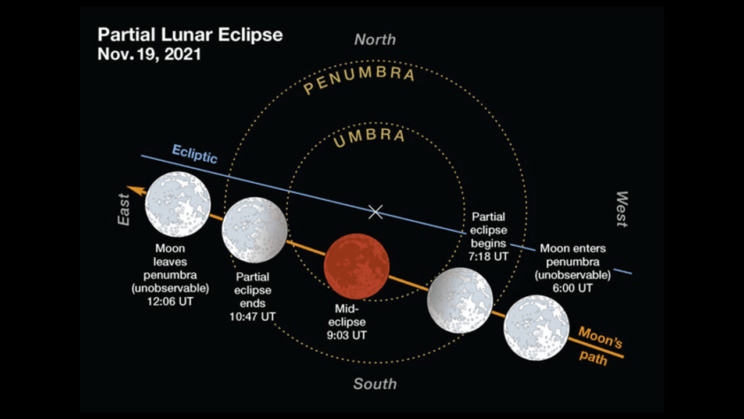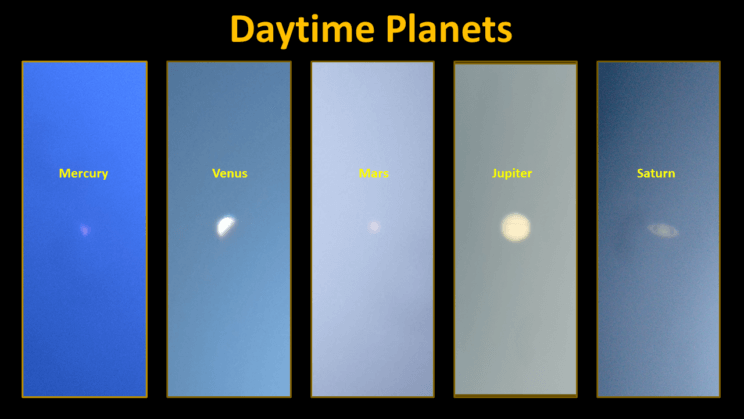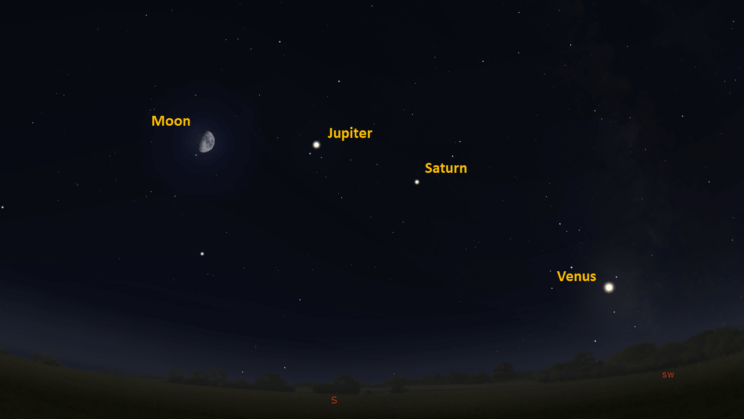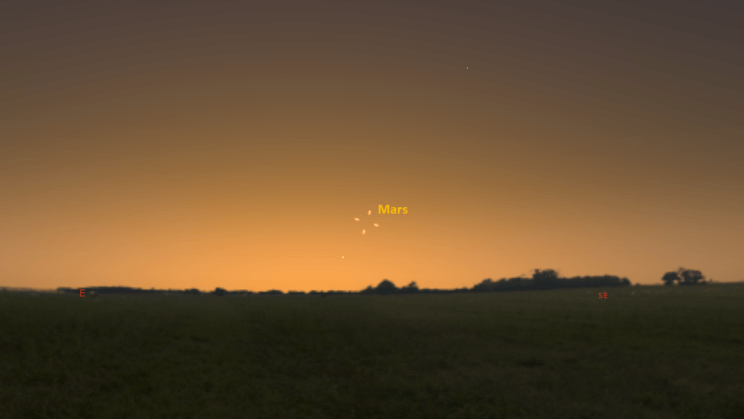This is the Saint Louis Science Center’s NIGHT SKY UPDATE for the week of Friday, November 12, 2021.
Information updated weekly or as needed.
Times given as local St. Louis time which is Central Standard Time (CST). For definitions of terminology used in the night sky update, click the highlighted text. If relying on times posted in Universal Time (UT), St. louis is -6 hours when CST.
Public Telescope Viewings
With the changing recommendations from the CDC regarding COVID-19, conversations regarding the return of star parties at the Saint Louis Science Center have begun. We are close to bringing back our public telescope viewings, but a few details still need to be worked out. We will post future updates as we learn more about when we can bring back telescope viewings.
Observing Highlight of the Week

Timing for the partial lunar eclipse on November 19, 2021. Image credit: skyandtelescope.org/observing/solar-and-lunar-eclipses-in-2021/
This week a Partial lunar eclipse occurs on November 19, 2021. During this eclipse, roughly 97% of the lunar disk will be seen in the Earth’s umbral shadow. With this much of the Moon in the umbral shadow, it is expected the Moon will appear red as it does during a total lunar eclipse. There is debate on this, but most agree the Moon is likely to take on a red color as it nears maximum eclipse.
Eclipses are an astronomical event called a syzygy. This is when three astronomical bodies in a gravitational system become aligned. The Earth, Moon and Sun are in syzygy twice in most months. This occurs when the Moon is in conjunction (new moon) and when the Moon is at opposition (full moon). Planets can also be involved in syzygies. Like the Moon, when a planet reaches conjunction or opposition, they are in syzygy with the Earth and Sun. Syzygies sometimes result in an occultation, transit or eclipse as is the case when the Moon reaches full moon on November 19, 2021. The events listed above are not an exhaustive list, but rather a sampling of what a syzygy is. The Earth’s tides, planning of deep space missions and predicting eclipses are all areas of interest that benefit from understanding syzygies.
Lunar eclipses occurs when the Moon passes through Earth’s shadow. The only time the Moon can pass through our shadow is during full moon. Earth’s shadow is comprised of two cone shapes in which one is nested inside the other. The penumbra is the outer part of Earth’s shadow in which the Sun’s rays are partially blocked. The Umbra is the inner portion of Earth’s shadow where the Sun’s rays are fully blocked. When the Moon passes through the penumbral shadow, very little change if any is visible. As the Moon enters the umbra, sunlight appears not to reach the portions in this section of Earth’s shadow. This causes parts of the Moon to seemingly disappear. When enough of the Moon is in the umbra, those portions take on a brownish to crimson red color. This variance in color and brightness is measured on the Danjon Scale of lunar eclipse brightness. This normally pertains to total lunar eclipses but deep partials like the one on November 19, 2021, are likely to exhibit the red coloring.
The red light illuminating the Moon during a lunar eclipse is the result of sunlight refracting through Earth’s atmosphere. During the day, shorter blue wavelengths of light are strongly scattered by air molecules. As the Sun sets, more of the visible spectrum is scattered leaving only longer wavelengths. This is the reason we see a slow change of colors at sunset. For more on this topic visit https://www.weather.gov/jetstream/color.
A total lunar eclipse appears red for the same reason. Once the Earth is in the way, it blocks most of the Sun’s light. The little bit of sunlight that passes through our thin atmosphere is refracted in a way that longer wavelengths like red light will dimly illuminate the lunar surface. As a partial eclipse begins, the small amount of the lunar surface reflecting red light is overpowered by the parts of the Moon still reflecting white light. Once enough of the Moon is in the umbra, the dim red light reflected towards us becomes visible as most of the Sun’s light is blocked by Earth or is scattered in Earth’s atmosphere. Even though it will not be a total eclipse on November 19, 2021, enough of the Moon will be inside the umbra that it is likely to appear some shade of red.
The color variance seen during lunar eclipses is a product the geometry of the Moon’s path through the umbra and the state of Earth’s atmosphere. Varying types of aerosols and other particulates can impact the color of light we see. Most of us have seen the Moon appear yellow or orange. This is often the result of volcanic eruptions, forest fires or other activities that increase particulates in the atmosphere. The color we see is an interesting way to study to conditions of our atmosphere.
The penumbral eclipse begins at 12:02 a.m. on November 19, 2021, CST. The partial eclipse begins at 1:18 a.m. CST as the Moon first enters Earth’s umbral shadow. The partial eclipse ends at 4:47 a.m. CST and the whole thing is over by 6:04 a.m. CST. Maximum eclipse occurs at 3:02 a.m. CST. When the eclipse begins, the Moon will be seen nearly overhead. By the end, you will need a clear view of the west. You won’t need binoculars or a telescope, but they can provide interesting views of the surface.
The next few years offer several eclipses to enjoy. In 2022, St. Louis will see two total lunar eclipses. The first is on May 15/16, 2022, and the second occurs on November 8, 2022. The next solar eclipse visible occurs on October 14, 2023. Parts of the American Southwest will see an annular eclipse but in St. louis we see a partial solar eclipse. Finally, on April 8, 2024, another total solar eclipse will be seen from North America. St. Louis will see about 99% of the Sun eclipsed that day, but if you drive a bit south to Cape Girardeau or Poplar Bluff, Missouri you can see roughly 4 minutes of totality. The next couple of years will be busy ones for eclipse fans.
Daytime Planets

The five naked eye planets seen in the daytime.
Credit: Eric Gustafson
Back in 2020, when much of the world found they had a little extra free time, I decided to explore the possibility of viewing planets in the daytime. The impetus for this was then the upcoming great conjunction of Jupiter and Saturn on December 21, 2020. Jupiter and Saturn reach conjunction every 20 years, and the 2020 conjunction was a particularly good one. The only downside was for us in St. Louis, the two planets appeared their closest in the daytime. So, I wanted to see what planets could be seen during the day.
Be aware that daytime viewing of planets can be dangerous because planets often appear close to the Sun. Looking directly at the Sun without optical aid can cause vision loss. To see planets in the daytime you need to use binoculars or a telescope. If you accidentally point them at the Sun, it WILL damage your eyes. Because of the inherent danger associated with daytime planet viewing, I would not recommend this to someone just learning to observe.
All observations mentioned after this were done using a 9.25” SCT telescope with a 12.5mm eyepiece. All images were captured using afocal imaging with a cellphone mounted to the eye piece.
I knew Venus would be visible, but I guessed the other naked eye planets might be visible as well. After Venus, Jupiter is the easiest planet to see in the daytime. Three hours after sunrise I could still see cloud details in the Jovian atmosphere. Saturn was tough to find but once found the rings were dimly visible in the daytime. Mars was surprising easy to see, likely because its red color contrasted well with the blue sky. And finally, Mercury was a bust. After not seeing Mercury I checked various observing forums, and some did mention Mercury as visible in the daytime, but it remained an elusive daytime target for me until November 2, 2021.
The key to spotting the naked eye planets in the daytime is knowledge of their orbits. This seems like an obvious statement, as knowing an object’s location is key to finding anything. That said, if you understand key terms related to a planet’s orbit such as opposition and superior or inferior conjunction, you will understand when something appears brighter or what you should see when observing it. For Mercury, the elusive planet is brightest when it exhibits a gibbous phase. This occurs before and after superior conjunction. Mercury is currently headed towards superior conjunction on November 28. The last time I tried Mercury in daytime was when it was headed toward inferior conjunction.
The main reason I decided to try Mercury again was because the Moon was set to occult Mercury on November 3. An occultation occurs when one object is hidden by another when it passes between it and the observer. In St. Louis, the occultation started around 2.39 p.m., which meant it had to be viewed in the daytime. As the occultation approached, what was most surprising was the Moon was not visible. It was less than a day away from new moon, but I still expected to see a bit of a thin waning crescent. I was able to capture Mercury disappearing behind the Moon.
The video below shows the occultation of Mercury on November 3. The dancing view of Mercury occurred because of atmospheric distortions. The twinkling of stars is a great example of this. Similarly, planets can appear to waver when viewed through a telescope. The magnitude of the distortion is dependent on atmospheric conditions. When visible, lunar occultations are only visible from a small part of the Earth. Much like you had to be in the right place to see the total solar eclipse in 2017, this lunar occultation was only visible from Canada, parts of the US and Bermuda. There are several resources available if you are interested in learning about these types of astronomical events. One of my go-to resources is the RASC publishes the Observer’s Handbook. Published annually, they document observing information for each year such as the lunar occultation of Mercury on November 3, 2021.
Lastly, once I spotted Mercury with a telescope, I tried binoculars. This time, Mercury was bright enough that I was able to find it with 7×42 binoculars. Backyard astronomy offers a multitude of things to look for beyond what is normally considered. If you do find an interest in daytime astronomy, make sure to use caution and never look directly at the Sun.
November 3, 2021 Mercury Occultation
Lunar Occultation of Mercury on November 3, 2021. Credit: Eric Gustafson
The Sun and Moon

The Moon as seen from the International Space Station, on July 31, 2011.
Credit: NASA
Sunrise is at 6:40 a.m. on Friday, November 12 and sunset is at 4:50 p.m. providing us with a bit over 10 hours of daylight. Even after sunset, the light from the Sun will dimly illuminate our sky for roughly 1 hour and 30 minutes. This period is called twilight, which ends around 6:21 p.m. this week. For those with a sundial, local noon occurs around 11:44 a.m. this week.
| Day | Sunrise | Sunset |
|---|---|---|
| 2021-11-12 | 6:40 a.m. | 4:50 p.m. |
| 2021-11-13 | 6:41 a.m. | 4:49 p.m. |
| 2021-11-14 | 6:42 a.m. | 4:48 p.m. |
| 2021-11-15 | 6:43 a.m. | 4:47 p.m. |
| 2021-11-16 | 6:44 a.m. | 4:47 p.m. |
| 2021-11-17 | 6:45 a.m. | 4:46 p.m. |
| 2021-11-18 | 6:46 a.m. | 4:45 p.m. |
| 2021-11-19 | 6:47 a.m. | 4:45 p.m. |
| 2021-11-20 | 6:49 a.m. | 4:44 p.m. |
Moon
Moonrise for Friday, November 12 occurs at 2:00 p.m. and moonset will occur on the following day ay at 6:40 p.m. On Friday, November 12 the Moon will exhibit a waxing gibbous phase with about 66% of the lunar disk illuminated. Full moon occurs on November 19 at 2:58 a.m. This will also be a night we see a partial lunar eclipse that runs from 12:02 a.m. until 6:04 a.m. on November 19, 2021.
International Space Station (ISS) Observing

Visible passes of ISS from St. Louis for the week of November 12 occur during evening hours. The best passes this week occurs on the evenings of November 18 and 19. Use the table below for information about these and other visible passes this week.
Catch ISS from St. Louis starting Friday, November 12
| Date | Starts | Max. altitude | Ends | |||||||
|---|---|---|---|---|---|---|---|---|---|---|
| Time | Alt. | Az. | Time | Alt. | Az. | Time | Alt. | Az. | ||
| 16 Nov | -2 | 18:23:24 | 10 | S | 18:25:11 | 21 | SSE | 18:25:11 | 21 | SSE |
| 17 Nov | -1.7 | 17:37:28 | 10 | SSE | 17:39:23 | 14 | SE | 17:40:34 | 13 | ESE |
| 17 Nov | -1 | 19:12:33 | 10 | WSW | 19:13:35 | 18 | WSW | 19:13:35 | 18 | WSW |
| 18 Nov | -3.9 | 18:25:29 | 10 | SW | 18:28:51 | 83 | SSE | 18:28:51 | 83 | SSE |
| 19 Nov | -3.3 | 17:38:41 | 10 | SSW | 17:41:56 | 46 | SE | 17:44:04 | 19 | ENE |
| 19 Nov | -0.7 | 19:16:07 | 10 | W | 19:17:04 | 15 | WNW | 19:17:04 | 15 | WNW |
| 20 Nov | -2.5 | 18:28:41 | 10 | W | 18:31:49 | 34 | NNW | 18:32:12 | 32 | NNW |
Magnitude (Mag): The Measure of brightness for a celestial object. The lower the value is, the brighter the object will be.
Altitude (Alt): The angle of a celestial object measured upwards from the observer’s horizon.
Azimuth (Az): The direction of a celestial object, measured clockwise from an observer’s location with north being 0°, east being 90°, south being 180° and west being 270°.
For information about ISS flyovers and other visible satellites, visit www.heavens-above.com
Detailed information regarding all unmanned exploration of our universe, missions past, present, and planned, can be found at Jet Propulsion Laboratories:
The Visible Planets

Looking South, at 6:00 p.m. November 12, 2021. Credit: Stellarium, EG

Looking east, at 6:20 am, November 14, 2021. Credit: Stellarium, EG
This week, three naked eye planets are visible. Venus can be found in the south southwest after sunset. Jupiter and Saturn can be found in the south after sunset. Early birds might catch a fleeting glimpse of Mars in the east just before sunrise after November 14, 2021.
Venus
Venus is well into another evening apparition. By 6:15 p.m., Venus will be about 16° above the south southwestern horizon. Venus will set at 7:25 p.m. Venus reached maximum eastern elongation October 29, 2021. Venus is now headed back towards the Sun as it approaches inferior conjunction on January 8, 2022.
Mars
Mars is about to start another apparition. After November 14, 2021, Mars will appear far enough from the Sun that those with clear eastern horizons might catch a fleeting glimpse of the Red Planet. On November 14, 2021, Mars will appear roughly 5° above the east-southeast horizon. This is only 20 minutes before sunrise so use caution if you plan to try to see Mars this week. Throughout 2022, Mars will head towards opposition on December 8, 2022. This is when Mars will be best for the current apparition.
Jupiter
Jupiter has passed opposition and as such will be visible about 30 minutes after sunset. Look for Jupiter in the south as it starts to darken outside. Jupiter sets at 11:25 p.m. and will set about 30 minutes earlier each week. Jupiter reaches superior conjunction on March 5, 2022. This means we can count on seeing Jupiter in the southern skies for the rest of this year and well into 2022.
Saturn
Saturn is past opposition which means it will be visible about 30 minutes after sunset. Right now, it can be found in the south after sunset, but as we continue through the year, Saturn will set about 30 minutes earlier each night. Saturn sets at 10:07 p.m. Saturn will reach superior conjunction on February 4, 2022.
James S. McDonnell Planetarium
Night Sky Update: November 12 – November 20, 2021






